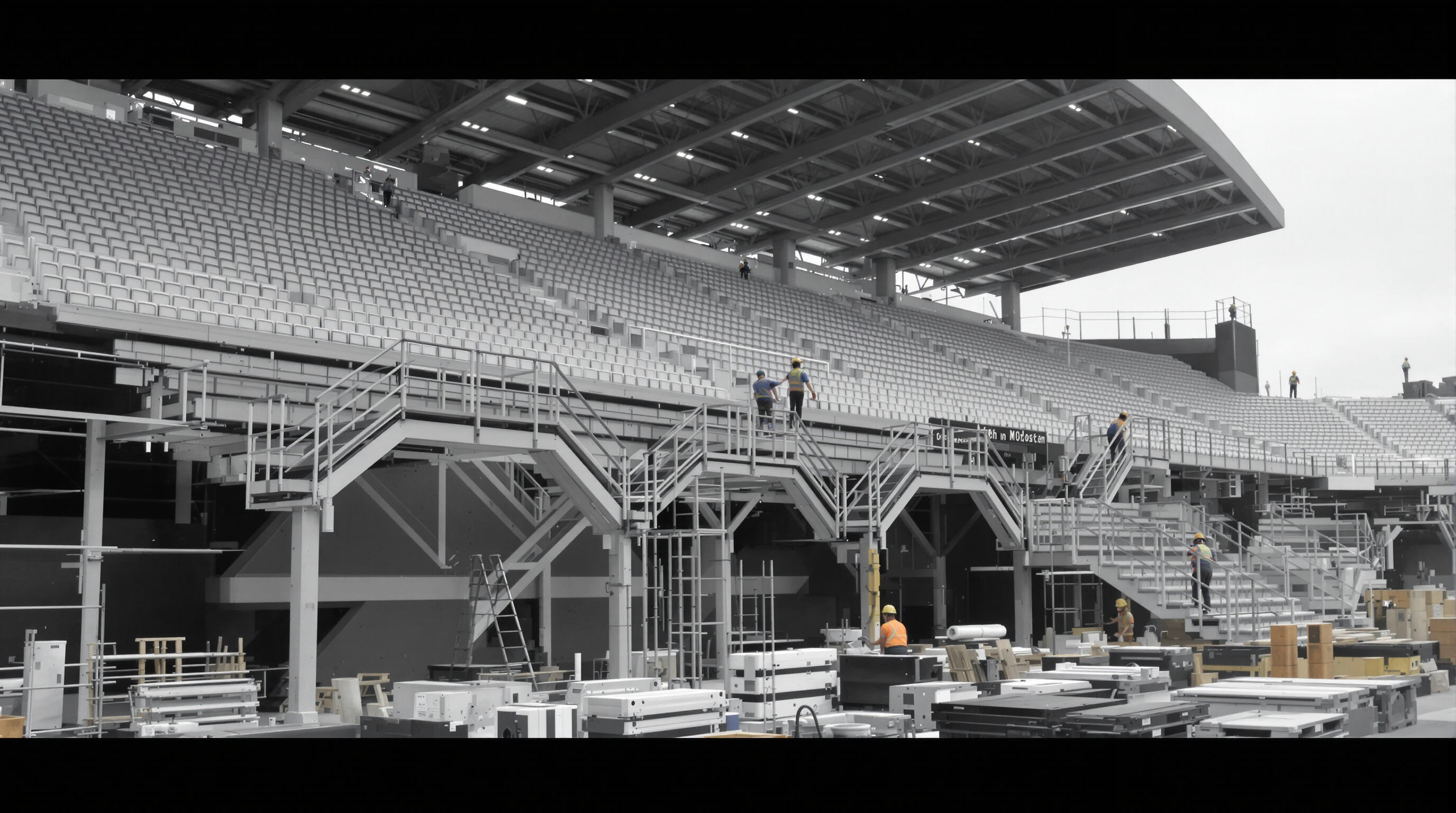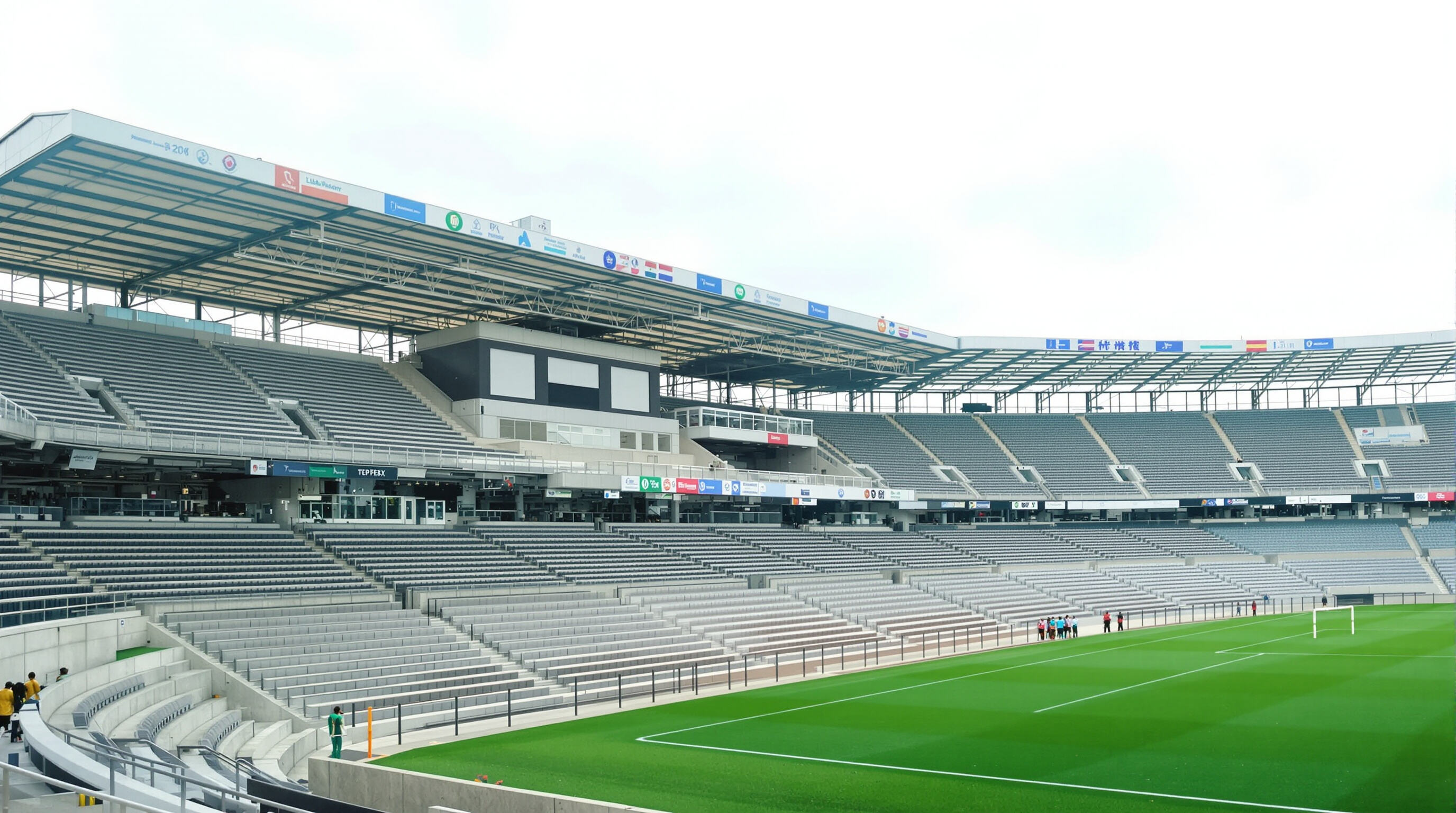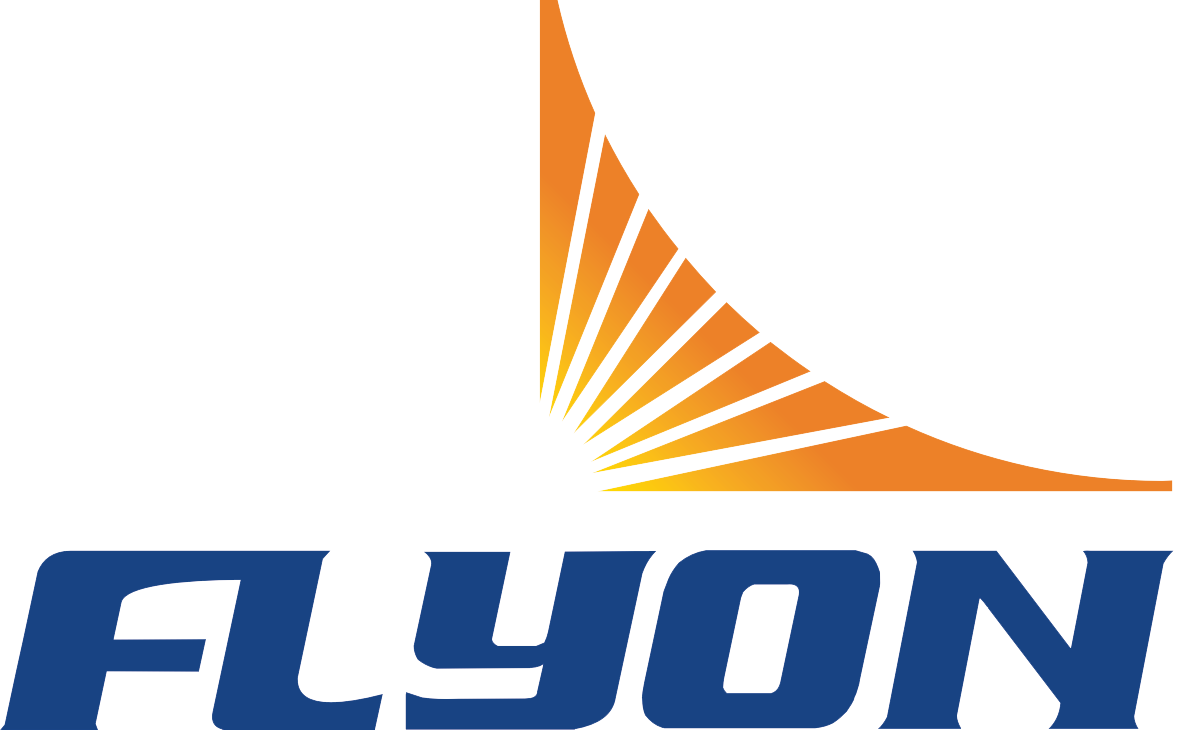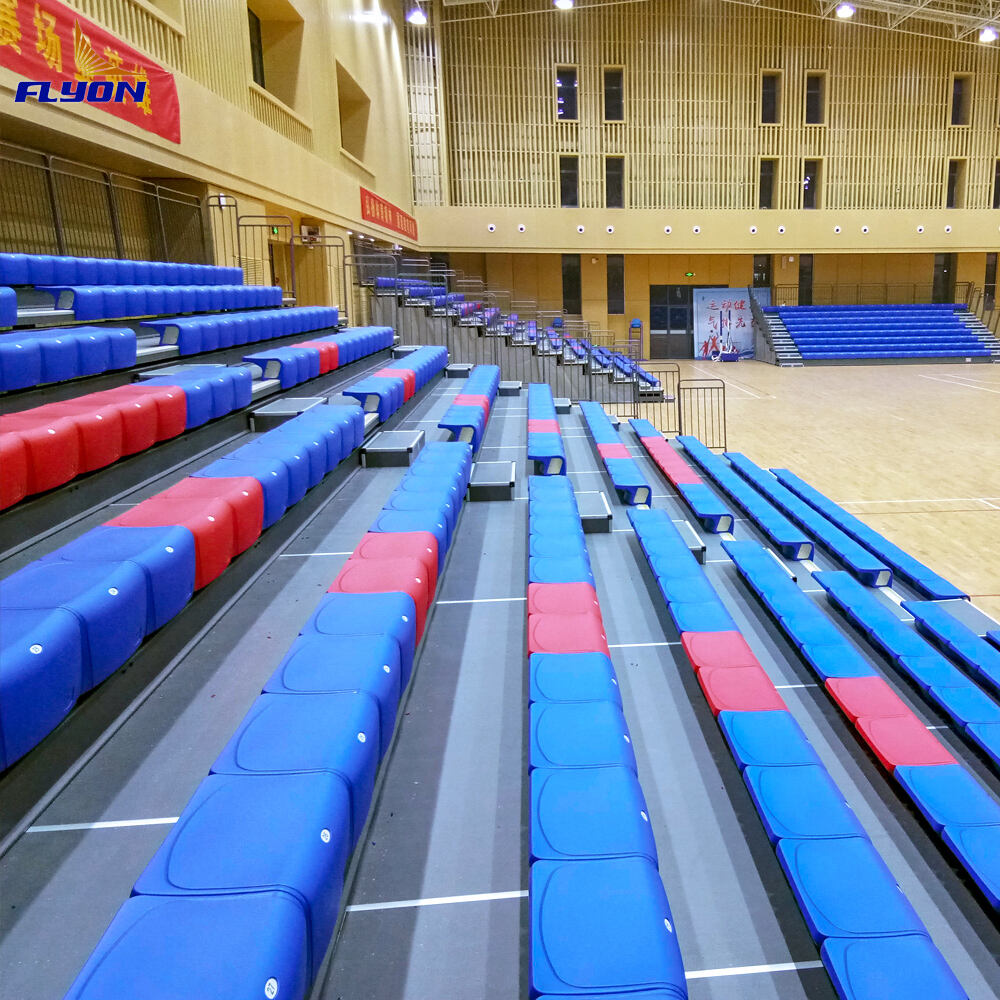Demanda creciente de recintos deportivos escalables
Los equipos deportivos actualmente están empezando a centrarse en configuraciones de estadios que pueden cambiar según la cantidad de aficionados que asistan y el tipo de eventos que necesiten espacio. Según algunas cifras recientes del Informe de Instalaciones Deportivas 2023, alrededor de dos tercios de los estadios de tamaño medio tienen dificultades para adaptarse a las variaciones en el número de espectadores a lo largo del año. Por eso cada vez son más los lugares que invierten en sistemas de asientos plegables, que les permiten ampliar o reducir su capacidad sin incurrir en gastos excesivos. Todo este movimiento tiene sentido si consideramos hacia dónde se dirige la industria en general: las instalaciones quieren ser más sostenibles y, al mismo tiempo, responder rápidamente a cualquier evento que se presente en la próxima temporada.
Cómo el diseño modular posibilita un crecimiento incremental

Los sistemas prefabricados de asientos para estadios permiten expansiones por fases mediante tres mecanismos clave:
- Módulos de asientos que se acoplan mediante pernos e integran con estructuras existentes
- Procesos de instalación reversibles que permiten reducciones de capacidad durante la temporada baja
- Componentes estandarizados compatibles con cambios futuros en la distribución
Estudios del sector muestran que los proyectos modulares completan las instalaciones iniciales de asientos 40% más rápido que las construcciones tradicionales de hormigón, con un 30 % menos de desperdicio de materiales (Stadium Engineering Journal 2024). Este enfoque reduce los compromisos iniciales de capital mientras se mantiene preparación para ampliaciones.
Estudio de caso: Estadios de fútbol de la USL con capacidad de asientos flexible
Ocho clubes de la United Soccer League (USL) han adoptado sistemas de asientos modulares desde 2021, demostrando una gestión escalable de la capacidad. Una franquicia ganadora del campeonato implementó unidades de gradas retráctiles que:
- Aumentaron la capacidad para playoffs en 3.200 asientos
- Se convirtieron en gradas de pie para conciertos en menos de 48 horas
- Reducjeron los costos anuales de mantenimiento en 18.000 dólares mediante la sustitución de componentes
Planificación para expansión futura utilizando sistemas de gradas modulares

Los operadores de recintos innovadores ahora exigen una capacidad de expansión del 15-20 % en los diseños básicos mediante infraestructuras modulares. Esta estrategia permite respuestas rentables ante:
- Escenarios de ascenso/descenso de equipos
- Regulaciones de seguridad en evolución
- Aumentos inesperados de asistencia
Los planificadores de estadios destacan el potencial de 25 años de vida útil de los sistemas modulares gracias a componentes sujetos al desgaste que pueden reemplazarse, una ventaja clave frente a las estructuras de hormigón permanentes que requieren sustitución completa tras 10–15 años de uso intensivo.
Expansión fácil e instalación rápida de asientos modulares para estadios
Sistemas de asientos modulares de instalación rápida para escalado ágil
Los últimos sistemas de asientos en gradas vienen con piezas especialmente diseñadas que se ensamblan fácilmente sin necesidad de equipo pesado, por lo que los estadios pueden instalar miles de asientos adicionales en solo unos días en lugar de esperar meses. Los recintos también pueden ajustar rápidamente su espacio cuando sea necesario, ya sea para partidos de playoffs inesperados, conciertos importantes o eventos especiales. Algunos lugares han logrado casi duplicar su área de asientos en épocas de mayor demanda, lo que hace que estas soluciones flexibles de asientos sean muy valiosas para los organizadores de eventos que buscan maximizar ganancias mientras reducen costos.
Información de datos: 40 % más rápido en instalación frente a la construcción tradicional
Los sistemas modulares de asientos para estadios reducen los plazos de instalación en un 40 % en comparación con las gradas de hormigón vertido. Las unidades prefabricadas llegan listas para el sitio, eliminando retrasos por curado de encofrados y contratiempos relacionados con el clima comunes en construcciones convencionales. Proyectos recientes que utilizan estos sistemas lograron estar completamente listos para espectadores 11 semanas antes de lo previsto.
Expansión Permanente vs. Modular: Evaluación de la Flexibilidad a Largo Plazo
Las estructuras permanentes de concreto sin duda aportan estabilidad a los recintos, pero tienen un costo. Los recintos terminan atrapados con ciertas capacidades para siempre, lo cual no tiene sentido cuando los eventos cambian con el tiempo. Ahí es donde las opciones modulares realmente destacan. Estos sistemas permiten a los organizadores mover asientos, almacenarlos cuando no se necesitan o incluso venderlos si el presupuesto se vuelve ajustado. La flexibilidad marca toda la diferencia en lugares que albergan desde grandes festivales de música con multitudes de 50 mil personas hasta partidos universitarios de baloncesto más pequeños con tal vez 5 mil aficionados. La mayoría de los recintos pueden reorganizar completamente su distribución de asientos en tres o cuatro días, a veces incluso más rápido dependiendo de cuánta ayuda reciban del personal y voluntarios.
Configuraciones Flexibles para Estadios y Eventos Multifuncionales
Adaptación de Asientos de Estadio para Necesidades Diversas de Eventos
Hoy en día, los estadios necesitan soluciones de asientos que puedan manejar todo tipo de eventos, desde grandes conciertos y espectáculos de teatro hasta ferias comerciales, exposiciones de arte y partidos de fútbol para niños los fines de semana. Los sistemas modulares de asientos disponibles actualmente permiten a los recintos cambiar su configuración bastante rápido, generalmente en un máximo de dos días, lo que les otorga una ventaja real en comparación con las disposiciones tradicionales de asientos fijos. Con características como gradas retráctiles y grupos de asientos que se pueden mover, los administradores de recintos tienen la flexibilidad para crear áreas VIP especiales cuando sea necesario, ampliar el espacio del vestíbulo durante eventos concurridos o incluso despejar secciones enteras para pistas de baile o puestos de exhibición, según lo requiera cada evento específico.
Asientos motorizados y retráctiles para una máxima flexibilidad del recinto
Los sistemas de asientos operados eléctricamente permiten ajustes de capacidad bajo demanda. Las plataformas telescópicas pueden ampliar un recinto de 10.000 asientos a 15.000 asientos para partidos de playoffs, y luego retraerse para albergar eventos más pequeños. Estos sistemas se integran con el software de gestión del estadio para un control preciso del tamaño de las secciones y las líneas de visión.
Estudio de caso: Estadios universitarios con asientos modulares de uso dual
Según una investigación publicada en 2023 sobre diseño flexible de estadios, disposiciones modulares de asientos permitieron a la Universidad de Michigan transformar su estadio de fútbol americano en centros de exámenes durante los períodos finales. Esta transformación redujo en aproximadamente dos tercios los días vacíos en las instalaciones, todo ello cumpliendo aún con las estrictas normas de la NCAA respecto a la capacidad de espectadores. Otras universidades también han tomado nota. Al menos media docena de programas de División I en todo el país han adoptado estrategias similares en los últimos años, aunque es difícil precisar el número exacto, ya que muchas instituciones no hacen públicos este tipo de cambios operativos.
Optimización del Espacio con Distribuciones de Asientos Reconfigurables
Componentes modulares permiten a los operadores crear zonas híbridas que combinan áreas para público de pie con gradas tradicionales. Las plataformas de asientos encajables pueden formar disposiciones circulares para torneos de esports o configuraciones lineales para competencias de atletismo, maximizando el ingreso por metro cuadrado. Los recintos que utilizan estas distribuciones informan un 25 % mayor aprovechamiento del espacio en comparación con diseños de asientos fijos.
Eficiencia de Costos y Ahorros a Largo Plazo con la Construcción Modular
Beneficios Económicos de los Sistemas Prefabricados de Asientos para Estadios
Los asientos para estadios fabricados en fábrica reducen alrededor de un 30 por ciento los materiales desperdiciados en comparación con los métodos convencionales, además de permitir mejores precios al comprar en grandes cantidades. Cuando los elementos se fabrican en fábricas controladas en lugar de in situ, los errores que normalmente aumentan los costos en aproximadamente un 18 por ciento simplemente ocurren con menos frecuencia. Esto facilita mucho la planificación presupuestaria para estadios deportivos y centros de eventos. Al estar todo estandarizado desde el principio, hay menos necesidad de diseños redundantes. El dinero ahorrado puede destinarse entonces a mejorar las instalaciones, como agregar puntos de acceso para sillas de ruedas o crear secciones VIP exclusivas que los aficionados adoran pero que de otro modo podrían no haber obtenido.
Reducción de costos laborales y de plazos en proyectos modulares
Los estadios construidos mediante métodos modulares finalizan aproximadamente un 40 por ciento más rápido en comparación con las técnicas de construcción convencionales, reduciendo los costos laborales alrededor de un 25 % según los estándares del sector para instalaciones deportivas. El menor tiempo de construcción significa que estos recintos pueden comenzar a generar ingresos mucho antes mediante la venta de entradas y otros flujos de ingresos por eventos. Algunos operadores incluso han recuperado su inversión en tan solo doce meses porque abrieron sus puertas antes de lo previsto. La construcción tradicional normalmente requiere trabajadores especializados en el lugar mismo de la obra, mientras que los enfoques modulares dependen de personal capacitado en fábrica que ensambla las piezas aproximadamente la mitad de tiempo que los equipos tradicionales, manteniendo aún así la seguridad y cumpliendo con todos los requisitos normativos durante todo el proceso.
Reutilización y reubicabilidad: Maximización del retorno sobre la inversión en asientos de estadio
Estudios sobre costos durante toda la vida útil indican que los sistemas de asientos reubicables ofrecen aproximadamente un 35 por ciento más de retorno de inversión después de quince años en comparación con las opciones fijas. Los recintos deportivos tienen la posibilidad de reutilizar estos componentes modulares para diversos eventos a lo largo del año o incluso vender los usados cuando ya no los necesiten. Esto significa que lo que antes era solo otro gasto se convierte ahora en algo valioso. Recientemente, un estadio universitario amplió sus instalaciones reduciendo casi a la mitad el presupuesto total, simplemente reorganizando algunas gradas modulares usadas en lugar de comprar equipos nuevos. Nada se acerca a este nivel de adaptabilidad si se comparan las instalaciones tradicionales de hormigón.
Soluciones Duraderas, Seguras y Cumplidas de Asientos Modulares para Estadios
Materiales y Acabados que Garantizan un Rendimiento a Largo Plazo
Las soluciones actuales de asientos en gradas combinan estructuras de HDPE con soportes de acero recubiertos con acabado en polvo, diseñados para resistir desde olas de calor extremo hasta lluvia helada y tráfico constante de personas. Recientemente, los fabricantes han comenzado a utilizar materiales especiales resistentes a los rayos UV, lo que significa que estos asientos pueden durar más de 15 años sin deteriorarse. Esto reduce las sustituciones aproximadamente en un 40 por ciento en comparación con los antiguos sistemas de madera que simplemente no podían mantener el ritmo. Los estadios deportivos y salas de conciertos se benefician especialmente de estas características debido al alto nivel de uso. Las superficies antideslizantes ayudan a prevenir accidentes, y los recubrimientos antimicrobianos realmente funcionan muy bien para mantener la limpieza entre eventos, cumpliendo además con los requisitos de las normas de seguridad ISO 45001.
Cumplimiento de la normativa ADA, barandillas y normas de seguridad
Los sistemas de asientos modulares deben cumplir con las directrices de la ADA, lo que significa contar con al menos 36 pulgadas de espacio para sillas de ruedas y líneas de visión despejadas a través del recinto. En áreas donde las gradas tienen una pendiente pronunciada, barandillas de seguridad de aproximadamente 42 pulgadas de altura ayudan a evitar caídas. Las superficies del piso también deben ser antideslizantes según las normas ASTM F1637, algo que muchos recintos pasan por alto hasta que ocurre un accidente. Considerando las novedades recientes en el mercado, los fabricantes han comenzado a incorporar luces integradas a lo largo de las salidas para que los asistentes puedan encontrar su salida de forma segura durante fallos de energía. Otra mejora consiste en asegurar que haya solo media pulgada de separación entre asientos a lo largo de cada fila, reduciendo así esos peligros de tropiezo que todos enfrentamos cuando corremos a nuestros asientos antes de que comience el espectáculo.
Comparación entre diseños modulares de gradas portátiles y fijas
| Característica | Sistemas portátiles | Sistemas Fijos |
|---|---|---|
| Tiempo de instalación | 2–3 días | 7–10 días |
| Recintos típicos | Eventos emergentes, uso estacional | Estadios profesionales |
| Durabilidad del Material | Aluminio de grado aeronáutico | Estructuras de acero galvanizado |
| Flexibilidad según la ADA | Acceso extraíble en la fila intermedia | Rampas preconfiguradas |
Los diseños portátiles priorizan la reconfiguración rápida para recintos multiusos, mientras que los sistemas fijos ofrecen soluciones permanentes con una vida útil de más de 25 años. Ambas opciones incorporan actualmente materiales ignífugos que cumplen con la normativa de seguridad EN 13501-1:2018, garantizando el cumplimiento sin sacrificar la comodidad del espectador.
Sección de Preguntas Frecuentes
¿Qué es el diseño modular de estadios?
El diseño modular de estadios se refiere al uso de componentes prefabricados que permiten expansiones por fases, opciones de asientos escalables y configuraciones flexibles en los estadios.
¿Por qué los recintos deportivos están adoptando sistemas de asientos modulares?
Los recintos deportivos están adoptando sistemas de asientos modulares para gestionar eficientemente tamaños variables de multitudes, ofrecer opciones escalables para diferentes tipos de eventos y reducir costos mediante una instalación rápida y disposiciones de asientos adaptables.
¿Cómo proporcionan ahorros a largo plazo los sistemas modulares?
Los sistemas modulares proporcionan ahorros a largo plazo mediante la reducción de residuos de materiales, tiempos de instalación más rápidos, reutilización de componentes y flexibilidad para adaptar las configuraciones de asientos según las necesidades actuales.
¿Son los sistemas de asientos modulares compatibles con las normas de seguridad?
Sí, los sistemas de asientos modulares están diseñados para cumplir con las directrices de la ADA, incluyen barandillas de seguridad, superficies antideslizantes y cumplen con las regulaciones de seguridad contra incendios para garantizar la seguridad y accesibilidad a largo plazo.
Tabla de Contenido
- Demanda creciente de recintos deportivos escalables
- Cómo el diseño modular posibilita un crecimiento incremental
- Estudio de caso: Estadios de fútbol de la USL con capacidad de asientos flexible
- Planificación para expansión futura utilizando sistemas de gradas modulares
- Expansión fácil e instalación rápida de asientos modulares para estadios
- Configuraciones Flexibles para Estadios y Eventos Multifuncionales
- Eficiencia de Costos y Ahorros a Largo Plazo con la Construcción Modular
- Soluciones Duraderas, Seguras y Cumplidas de Asientos Modulares para Estadios
- Sección de Preguntas Frecuentes
 EN
EN
 AR
AR
 FR
FR
 PT
PT
 RU
RU
 ES
ES
 BG
BG
 HR
HR
 CS
CS
 DA
DA
 NL
NL
 FI
FI
 DE
DE
 EL
EL
 HI
HI
 IT
IT
 JA
JA
 KO
KO
 NO
NO
 PL
PL
 RO
RO
 SV
SV
 CA
CA
 TL
TL
 ID
ID
 SR
SR
 SK
SK
 UK
UK
 VI
VI
 HU
HU
 TH
TH
 TR
TR
 MS
MS
 AZ
AZ
 KA
KA
 BN
BN
 LO
LO
 MN
MN
 MY
MY
 UZ
UZ


